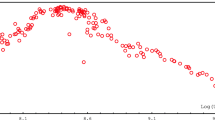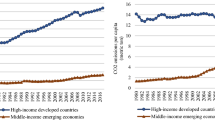Abstract
As the main greenhouse gas, carbon dioxide (CO2) has been under intensive studied in the last two decades. This paper addresses the research that whether the environmental Kuznets curve (EKC) for CO2 emissions exists in G20 group—an international forum for governments and central banks from 19 countries and European Union. To analyze the studied relationship thoroughly, other four explanatory variables—two trade openness terms, the ratio of secondary industry value-added to GDP and population density—are employed to investigate whether they have any influences on the existence and shapes of EKC. In the empirical study, two multinational panel data sets covering the periods between 1960 and 2010 (50 years) and between 1990 and 2010 (20 years) are utilized, and the panel data fixed effects and generalized method of moments estimators are employed. The estimation results indicate that the EKC indeed exists in the G20 members as a whole. To investigate whether the existence of EKC depends on the level of economic growth, the G20 countries are further divided into two subgroups: developed and developing countries. Although the estimation results suggest that there exists EKC in developing countries during both 20- and 50-year period, there is no persuasive evidence to prove the existence of EKC in developed countries during the 20-year period. For the time periods we studied, most developed countries have seen relatively stable or even decreasing CO2 emissions, while for the majority of the developing countries, the peak of CO2 emissions could not be reached in the near future.
Access this article
We’re sorry, something doesn't seem to be working properly.
Please try refreshing the page. If that doesn't work, please contact support so we can address the problem.




Similar content being viewed by others
Notes
The Russia Federation is excluded over 1960–2010 while included over 1990–2010. The reason that Russia Federation is excluded in the 50-year period will be demonstrated later.
Because Germany’s per capita GDP data is only available since the year 1970, the period presented in this dataset starts from 1970 to 2010.
References
Aldy JE (2005) An environmental Kuznets curve analysis of U.S. State-Level Carbon Dioxide Emissions. J Environ Dev 14(1):48–72
Apergis N, Payne JE, Menyah K, Wolde-Rufael Y (2010) On the causal dynamics between emissions, nuclear energy, renewable energy, and economic growth. Ecol Econ 69(11):2255–2260
Arellano M, Bover O (1995) Another look at the instrumental variable estimation of error-components models. J Econometrics 68(1):29–51
Arto I, Erik D (2014) Drivers of the growth in global greenhouse gas emissions. Environ Sci Technol 48(10):5388–5394
Auffhammer M, Carson RT (2008) Forecasting the path of China’s CO2 emissions using province-level information. J Environ Econ Manag 55(3):229–247
Azomahoua T, Laisney F, Van PN (2005) Economic development and CO2 emissions: a nonparametric panel approach. J Public Econ 90(6–7):1347–1363
Baltagi HB (2005) Econometric analysis of panel data, 3rd edn. Wiley, Chichester
Bond SR, Hoeffler A, Temple JRW (2001) Gmm estimation of empirical growth models. Econ Papers 159(1):99–115
Carson RT (2010) The environmental Kuznets curve: seeking empirical regularity and theoretical structure. Rev Environ Econ Policy 4(1):3–23
Chang CC (2010) A multivariate causality test of carbon dioxide emissions, energy consumption and economic growth in China. Appl Energy 87(11):3533–3537
Chiu YB (2012) Deforestation and the environmental Kuznets curve in developing countries: a panel smooth transition regression approach. Can J Agric Econ 60(2):177–194
Dinda S (2004) Environmental Kuznets curve hypothesis: a survey. Ecol Econ 49(4):431–455
Du L, Wei C, Cai S (2012) Economic development and carbon dioxide emissions in China: provincial panel data analysis. China Econ Rev 23(2):371–384
Ekins P (1993) ‘Limits to growth’ and ‘sustainable development’: grappling with ecological realities. Ecol Econ 8(3):269–288
Grossman GM, Krueger AB (1995) Economic growth and the environment. Q J Econ 110(2):353–377. doi:10.2307/2118443
Hao Y, Liu YM (2015) Has the development of FDI and foreign trade contributed to China’s CO2 emissions? An empirical study with provincial panel data. Nat Hazards 76(2):1079–1091
Hao Y, Zhang Q, Zhong M, Li B (2015) Is there convergence in per capita SO2 emissions in China? An empirical study using city-level panel data. J Clean Prod 108:944–954
Hao Y, Chen H, Zhang Q (2016) Will income inequality affect environmental quality? Analysis based on China’s provincial panel data. Ecol Indic 67:533–542
He J (2014) Analysis of CO2 emissions peak: China’s objective and strategy. Chin J Popul Resour Environ 12(3):189–198
Holtz-Eakin D, Selden TM (1995) Stoking the fires? CO2 emissions and economic growth. J Public Econ 57(1):85–101
IEA (2010) World energy outlook 2010.International Energy Agency, Paris
Jaffe AB, Newell RG, Stavins RN (2000) Technological change and the environment. Handb Environ Econ 1(03):461–516
Jain S, Chaudhuri TD (2009) The environmental Kuznets curve: a reaffirmation. ICFAI J Environ Econ 7(2):7–29
Jakob M, Marschinski R (2013) Interpreting trade-related CO2 emission transfers. Nat Clim Change 3(1):19–23
Kaika D, Zervas E (2013) The environmental Kuznets curve (EKC) theory—part A: concept, causes and the CO2 emissions case. Energy Policy 62:1392–1402. doi:10.1016/j.enpol.2013.07.131
Kanjilal K, Ghosh S (2013) Environmental Kuznet’s curve for India: evidence from tests for cointegration with unknown structuralbreaks. Energy Policy 56:509–515
Kohler M (2013) CO2 emissions, energy consumption, income and foreign trade: a South African perspective. Energy Policy 63:1042–1050
Kuznets S (1955) Economic growth and income inequality. Am Econ Rev 45(1):1–28
Lieb CM (2003) The environmental Kuznets curve: a survey of the empirical evidence and of possible causes. Discussion paper
Managi S, Hibiki A, Tsurumi T (2009) Does trade openness improve environmental quality? J Environ Econ Manag 58(3):346–363
Menyah K, Wolde-Rufael Y (2010) CO 2 emissions, nuclear energy, renewable energy and economic growth in the US. Energy Policy 38(6):2911–2915
Millimet DL, List JA, Stengos T (2002) The environmental Kuznets curve: real progress or misspecified models? Rev Econ Stat 85(85):1038–1047
Musolesi A, Mazzanti M, Zoboli R (2010) A panel data heterogeneous Bayesian estimation of environmental Kuznets curves for CO2 emissions. Appl Econ 42(18):2275–2287
Perman R, Stern DI (2003) Evidence from panel unit root and cointegration tests that the environmental Kuznets curve does not exist. Aust J Agric Resour Econ 47(3):325–347
Selden TM, Song D (1994) Environmental quality and development: Is there a Kuznets curve for air pollution emissions? J Environ Econ Manag 27(2):147–162
Shafik N, Bandyopadhyay S (1992) Economic growth and environmental quality: time series and cross-country evidence. Policy research working paper
Song T, Zheng T, Tong L (2008) An empirical test of the environmental Kuznets curve in China: a panel cointegration approach. China Econ Rev 19(3):381–392
Stern DI (2004). The rise and fall of the environmental Kuznets curve. World Dev 32(8):1419–1439
Tian J, Liao H, Wang C (2015) Spatial–temporal variations of embodied carbon emission in global trade flows: 41 economies and 35 sectors. Nat Hazards 78(2):1–20
Wang SS, Zhou DQ, Zhou P, Wang QW (2011) CO2 emissions, energy consumption and economic growth in China: a panel data analysis. Energy Policy 39(9):4870–4875
Zhang Y-J, Da Y-B (2013) Decomposing the changes of energy-related carbon emissions in China: evidence from the PDA approach. Nat Hazards 69(1):1109–1122
Zhang Y-J, Da Y-B (2015) The decomposition of energy-related carbon emission and its decoupling with economic growth in China. Renew Sustain Energy Rev 41:1255–1266
Zhang Y-J, Liu Z, Zhang H, Tan T-D (2014) The impact of economic growth, industrial structure and urbanization on carbon emission intensity in China. Nat Hazards 73(2):579–595
Zhang Y-J, Bian X-J, Tan W, Song J (2015) The indirect energy consumption and CO2 emission caused by household consumption in China: an analysis based on the input–output method. J Clean Prod. doi:10.1016/j.jclepro.2015.08.044
Acknowledgments
The authors acknowledge the financial support from the National Natural Science Foundation of China (71403015, 71521002), Beijing Natural Science Foundation (9162013), and the Joint Development Program of Beijing Municipal Commission of Education.
Author information
Authors and Affiliations
Corresponding author
Rights and permissions
About this article
Cite this article
Luo, G., Weng, JH., Zhang, Q. et al. A reexamination of the existence of environmental Kuznets curve for CO2 emissions: evidence from G20 countries. Nat Hazards 85, 1023–1042 (2017). https://doi.org/10.1007/s11069-016-2618-0
Received:
Accepted:
Published:
Issue Date:
DOI: https://doi.org/10.1007/s11069-016-2618-0




